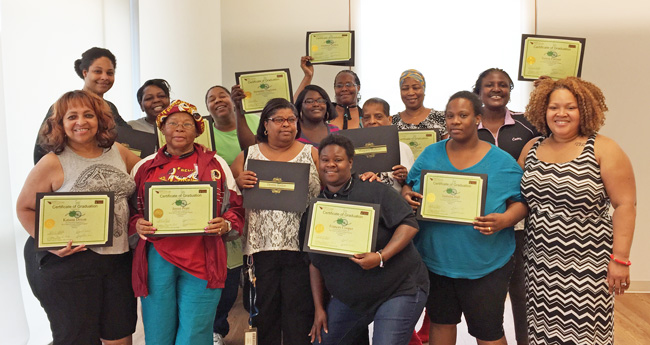Share This
For her final A Taste of African Heritage (ATOAH) lesson this summer at Unity Health Clinic Parkside, D.C. instructor LaShell Staples asked her students to bring in their favorite dishes from the curriculum, creating an ATOAH potluck celebration. Students brought a number of dishes they’d learned about, including Caribbean red beans, sweet potato Mafe stew, brown rice, a cucumber and spinach salad, and fresh mango with coconut dessert. Adding a scoop of each dish to their plates, LaShell’s students created the perfect picture of what a healthy heritage plate can look like. We wanted to share some tips on building your own heritage plates at home!
A Taste of African Heritage Graduates at Unity Health Clinic Parkside
Building a healthy heritage plate is so much fun and allows you to be as creative as you like, with many different kinds of traditional ingredients to choose from. Whether you’re preparing a Greek- or Thai- or Nigerian-inspired meal, a healthy heritage plate bursts with colors, regional flavors, and plant-based foods.
Steps to Building A Healthy Heritage Plate
Pick your vegetables and leafy greens. Steamed, sautéed, roasted, grilled or raw, enjoy vegetables in larger portions to the other parts of your plate. Add leafy greens, as part of a vegetable medley or as their own side. If you’re grabbing seconds, go for the veggies!
Choose your whole grain or tuber. Neutral-flavored whole grains and tubers make wonderful, filling bases for whatever you’re cooking. Making bok choy tonight? Boil up a pot of rice noodles, Jasmine brown rice, or Japanese yams to make an Asian-inspired meal. Or are you charring okra and peppers? Put on a pot of millet or mash sweet potatoes for an African heritage meal. Whether you’re roasting eggplant or sautéing cabbage, whole grain pasta, quinoa, millet, brown or wild rice, farro, noodles, and spelt are just a few of the whole grain vehicles you can choose from to carry flavorful sauces, vegetables, beans, and other ingredients. *Start these items first, as they take the longest time, but cook themselves and need little attention. Get everything else prepared while your grains or tubers cook.
Make beans a regular protein staple. Sauté rinsed canned beans with garlic, olive oil and your favorite spices, to make dishes like Oldways Spicy Chickpeas. Or cook up a big pot of dried beans and store them in your refrigerator to reheat throughout the week. When preparing meats, use lean cuts and smaller amounts (about half the size of your palm), and opt for fish and fresh seafood whenever possible.
Add a simple salad or pickle. Salads don’t have to be lettuce-driven only. A salad can use just about any raw vegetable you like, the simpler the better as part of a meal. If you have radishes or cucumbers on hand, marinate them in a splash of olive oil, an acid (vinegar or fresh citrus juice), and a pinch of salt, to serve chilled as one of your plate items.
Enjoy fruit for dessert. Along with many important vitamins, fruit contains enzymes that help us digest. Slice up your favorite fruits, dust with a chopped nuts, and drizzle with a few tablespoons of coconut milk. Chill while you eat, and enjoy at the end!
And, voila! You can create a robust, healthy heritage plate, boasting so many different flavors, nutrients and cultural flavors, in less than 20 minutes every day.
Join us for more heritage plate sharing at our A Taste of African Heritage Facebook Group or join a class happening near you. Our 4-Week Diet Menu Plans also offer wonderful guides on putting Oldways’ Mediterranean and Vegetarian & Vegan traditional diet pyramids into practice for breakfast, lunch, and dinner.
Many thanks to the University of the District of Columbia’s Center for Nutrition, Diet and Health (CNDH) for making LaShell’s D.C.-based class possible.
~ Sarah McMackin, The African Heritage & Health Program




Add a Comment